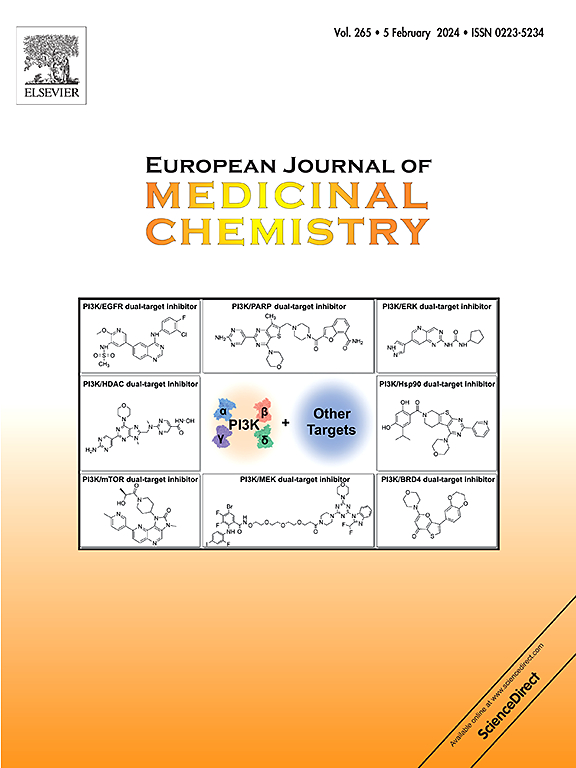Mechanistic analysis of diverse click reactions along with their applications
IF 6
2区 医学
Q1 CHEMISTRY, MEDICINAL
引用次数: 0
Abstract
The emergence of click chemistry has changed the face of chemical synthesis in the direction of modular, high-yielding, and greener reactions. The past two decades have evidenced a tremendous pace in the development of click chemistry and its applications in synthetic, pharmaceutical and allied sciences. Click chemistry shakes hands with green chemistry and enables chemists to dive deeper into newer chemical transformations with minimal harm caused to the environment. The present review describes the principles of click chemistry, its origin and innovations. Most relevant reactions within the click chemistry framework, including copper(I)-catalyzed azide-alkyne cycloaddition (CuAAC), strain-promoted azide-alkyne cycloaddition (SPAAC), and other crucial methodologies like thiol-ene reactions are discussed along with their mechanisms. Furthermore, applications of click chemistry have been discussed in pharmacotherapeutic and chemical aspects. These reactions have demonstrated unparalleled versatility across all areas of science due to their biocompatibility, efficiency and reliability, making them into the spotlight for discovering new drugs and optimizing them. Applications of click chemistry in the bio labeling mechanism as it precisely produces molecular images or diagnostics while undertaking proteomics and proteolysis-targeting chimeras (PROTACs) are also discussed. This holistic review follows the transformative influence of click chemistry through interdisciplinary fields. It sets the impetus for biomedical innovation, chemical biology innovation, and materials science innovation in biomedical research. With its modularity and robustness, click chemistry will continue to stretch the paradigms of synthetic and applied chemistry and may become indispensable in solving complex scientific challenges.


各种点击反应的机理分析及其应用
点击化学的出现改变了化学合成的面貌,使其朝着模块化、高产、绿色的方向发展。在过去的二十年里,点击化学及其在合成、制药和相关科学中的应用取得了巨大的发展。点击化学与绿色化学握手,使化学家能够更深入地研究更新的化学转化,同时对环境造成最小的危害。本文综述了点击化学的原理、起源和创新之处。在点击化学框架内的大多数相关反应,包括铜(I)催化叠氮化物-炔环加成(CuAAC),菌株促进叠氮化物-炔环加成(SPAAC),以及其他关键的方法,如硫醇反应及其机理进行了讨论。此外,还讨论了点击化学在药物治疗和化学方面的应用。由于其生物相容性、效率和可靠性,这些反应在所有科学领域都表现出无与伦比的多功能性,使它们成为发现新药和优化药物的焦点。点击化学在生物标记机制中的应用,因为它在进行蛋白质组学和靶向蛋白质水解嵌合体(PROTACs)的同时精确地产生分子图像或诊断。这篇全面的综述通过跨学科领域跟踪点击化学的变革性影响。它为生物医学研究中的生物医学创新、化学生物学创新和材料科学创新提供了动力。凭借其模块化和健壮性,点击化学将继续扩展合成化学和应用化学的范式,并可能成为解决复杂科学挑战不可或缺的工具。
本文章由计算机程序翻译,如有差异,请以英文原文为准。
求助全文
约1分钟内获得全文
求助全文
来源期刊
CiteScore
11.70
自引率
9.00%
发文量
863
审稿时长
29 days
期刊介绍:
The European Journal of Medicinal Chemistry is a global journal that publishes studies on all aspects of medicinal chemistry. It provides a medium for publication of original papers and also welcomes critical review papers.
A typical paper would report on the organic synthesis, characterization and pharmacological evaluation of compounds. Other topics of interest are drug design, QSAR, molecular modeling, drug-receptor interactions, molecular aspects of drug metabolism, prodrug synthesis and drug targeting. The journal expects manuscripts to present the rational for a study, provide insight into the design of compounds or understanding of mechanism, or clarify the targets.

 求助内容:
求助内容: 应助结果提醒方式:
应助结果提醒方式:


